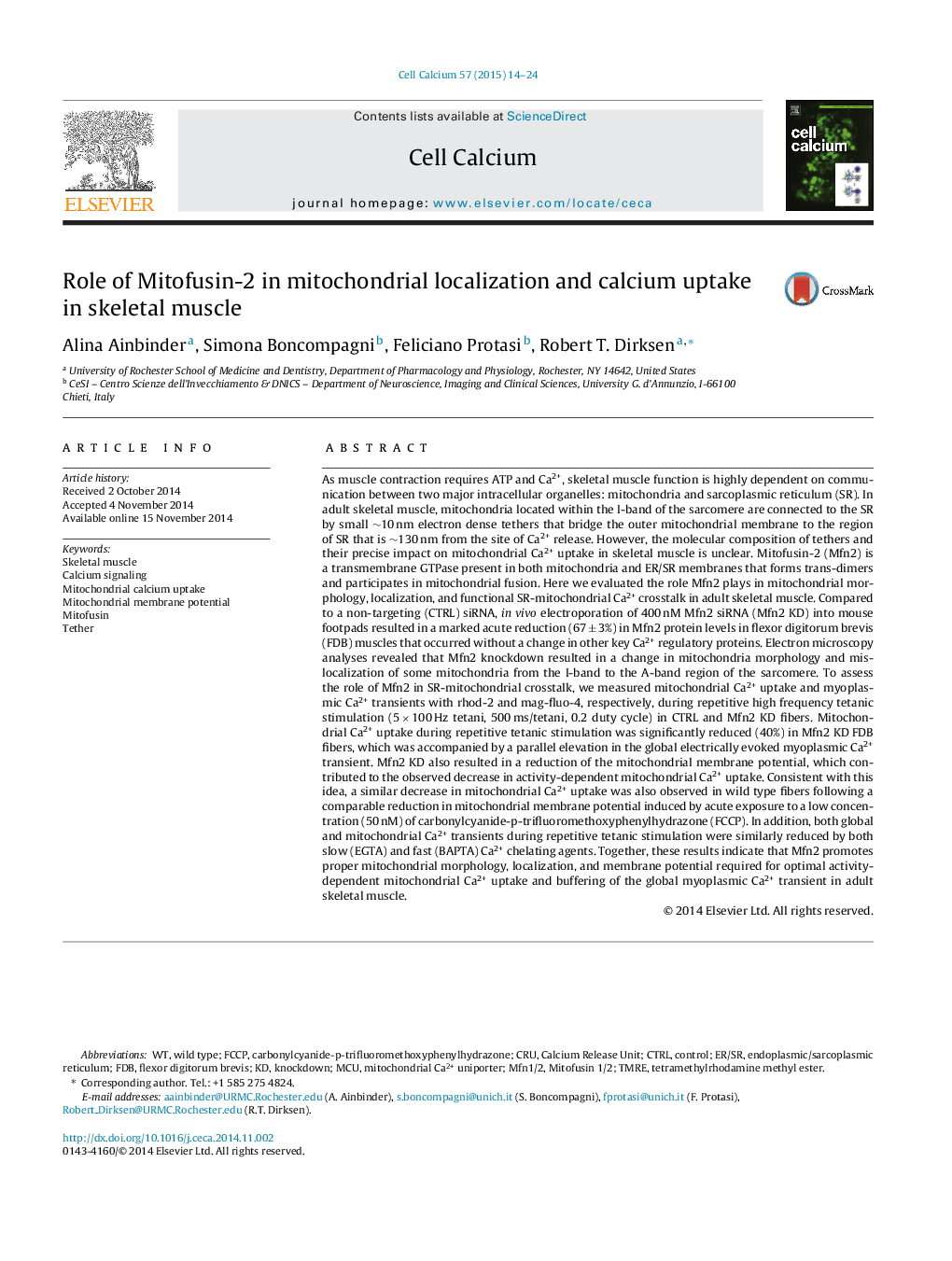| کد مقاله | کد نشریه | سال انتشار | مقاله انگلیسی | نسخه تمام متن |
|---|---|---|---|---|
| 2165891 | 1091783 | 2015 | 11 صفحه PDF | دانلود رایگان |
• Mfn2 knockdown in muscle causes mitochondrial fragmentation and mis-localization.
• Mfn2 knockdown in muscle reduces mitochondrial Ca2+ uptake.
• Mfn2 knockdown in muscle depolarizes the mitochondrial membrane potential.
• Mitochondria in muscle respond to changes in the bulk myoplasmic Ca2+ pool.
• Mfn2 is required for optimal mitochondrial Ca2+ uptake in skeletal muscle.
As muscle contraction requires ATP and Ca2+, skeletal muscle function is highly dependent on communication between two major intracellular organelles: mitochondria and sarcoplasmic reticulum (SR). In adult skeletal muscle, mitochondria located within the I-band of the sarcomere are connected to the SR by small ∼10 nm electron dense tethers that bridge the outer mitochondrial membrane to the region of SR that is ∼130 nm from the site of Ca2+ release. However, the molecular composition of tethers and their precise impact on mitochondrial Ca2+ uptake in skeletal muscle is unclear. Mitofusin-2 (Mfn2) is a transmembrane GTPase present in both mitochondria and ER/SR membranes that forms trans-dimers and participates in mitochondrial fusion. Here we evaluated the role Mfn2 plays in mitochondrial morphology, localization, and functional SR-mitochondrial Ca2+ crosstalk in adult skeletal muscle. Compared to a non-targeting (CTRL) siRNA, in vivo electroporation of 400 nM Mfn2 siRNA (Mfn2 KD) into mouse footpads resulted in a marked acute reduction (67 ± 3%) in Mfn2 protein levels in flexor digitorum brevis (FDB) muscles that occurred without a change in other key Ca2+ regulatory proteins. Electron microscopy analyses revealed that Mfn2 knockdown resulted in a change in mitochondria morphology and mis-localization of some mitochondria from the I-band to the A-band region of the sarcomere. To assess the role of Mfn2 in SR-mitochondrial crosstalk, we measured mitochondrial Ca2+ uptake and myoplasmic Ca2+ transients with rhod-2 and mag-fluo-4, respectively, during repetitive high frequency tetanic stimulation (5 × 100 Hz tetani, 500 ms/tetani, 0.2 duty cycle) in CTRL and Mfn2 KD fibers. Mitochondrial Ca2+ uptake during repetitive tetanic stimulation was significantly reduced (40%) in Mfn2 KD FDB fibers, which was accompanied by a parallel elevation in the global electrically evoked myoplasmic Ca2+ transient. Mfn2 KD also resulted in a reduction of the mitochondrial membrane potential, which contributed to the observed decrease in activity-dependent mitochondrial Ca2+ uptake. Consistent with this idea, a similar decrease in mitochondrial Ca2+ uptake was also observed in wild type fibers following a comparable reduction in mitochondrial membrane potential induced by acute exposure to a low concentration (50 nM) of carbonylcyanide-p-trifluoromethoxyphenylhydrazone (FCCP). In addition, both global and mitochondrial Ca2+ transients during repetitive tetanic stimulation were similarly reduced by both slow (EGTA) and fast (BAPTA) Ca2+ chelating agents. Together, these results indicate that Mfn2 promotes proper mitochondrial morphology, localization, and membrane potential required for optimal activity-dependent mitochondrial Ca2+ uptake and buffering of the global myoplasmic Ca2+ transient in adult skeletal muscle.
Figure optionsDownload as PowerPoint slide
Journal: Cell Calcium - Volume 57, Issue 1, January 2015, Pages 14–24
